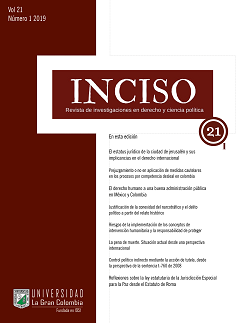El The legal status of the city of Jerusalem and its implications in international
Abstract
The present work intends to analyze the current conflict around the city of Jerusalem through the different elements that constitute the main center of the controversy, including the legal, religious, political and historical elements. The conflict, in turn, confronts two different subjects, on the one hand a State, the Israeli State; on the other, the Palestinian Authority, which is not yet recognized as a State, with all the rights and obligations that such a condition implies (Mouton, 1996, p.967). The methodology used here (consists) of the analysis of historical sources, current data of international organizations, and doctrine of the International Court of Justice. The most significant conclusion, drawn from the results of the present work, is the confirmation that the conflict around the city should be resolved taking into account the positions of the two parts involved, the needs of the population, and the background of the negotiations so far carried out.Downloads
References
Barboza, J. (2001). Derecho Internacional Público. Buenos Aires: Zavalia, 2° edición.
Berkovitz, S. (2001). The Temple Mount and the Western Wall in Israeli Law. Jerusalén: The Jerusalem Institute for Israel Studies.
Brownlie, I. (2009).The Peaceful Settlement of International Disputes. Chinese Journal of International Law, 8(2), 267-283.
Esposito, C. (1996). La jurisdicción consultiva de la Corte Internacional de Justicia. Madrid: McGraw-Hill.
Gold, D. (2007). The Fight for Jerusalem. Radical Islam, the West, and the Future of the Holy City. Washington: Regnery Publishing, Inc.
Gutierrez posse, H.D. (2014). Elementos de Derecho Internacional Humanitario. Buenos Aires: Eudeba, 1° edición.
Haupais, N. (2007). Les obligations de la puissance occupante au regard de la jurisprudence et de la pratique récentes. Revue Générale de Droit International Public, 111(1), 117-147.
Kimhi, I. (2006). The operational regime of the security fence around Jerusalem: Potential implications for the city. En Kimhi, I. (Ed), The Security Fence around Jerusalem: Implications for the City and Its Residents (pp.15-31). Jerusalén: Jerusalem Institute for Israel Studies.
Kimhi, I., Choshen, M., y Assap-shapira, Y. (2006). Jerusalem as a Component of Israel’s National Strength, Indicators of the State of the Capital, and a View to the Future. Jerusalén: Jerusalem Institute for Israel Studies.
Klein, M. (2001). Jerusalem the contested city. Jerusalén: Jerusalem Institute for Israel Studies.
Kuete Minga, R. (1997). Le Traité de paix du 26 octobre 1994 entre l’État d’Israël et le Royaume Hachémite de Jordanie. Revue Générale de Droit International Public, 101(2), 391-421.
Lehrs, L. (2011). Peace talks over Jerusalem. Review of the Israeli-Palestinian Negotiations Concerning Jerusalem 1993-2011. Jerusalén: Jerusalem Institute for Israel Studies.
Mouton, J.D. (1996). L’autonomie palestinienne après l’accord intérimaire israélo-palestinien du 28 septembre 1995. Revue Générale de Droit International Public, 100(4), 951-977.
Poissonnier, G., y Osseland, P. (2010). Les colonies israéliennes de Cisjordanie en droit international. Revue Générale de Droit International Public, 114(1), 63-92.
Ratner, S.R. (2005). Foreign Occupation and International Territorial Administration: The Challenges of Convergence. The European Journal of International Law, 16(4), 695-719.
Ribeiro Roriz, J.H., Fernandes Carvalho Veçoso, F., y Da Silva Tasquetto, L. (2013). A administração de territórios ocupados: indeterminação das normas de direito internacional humanitário? Revista de direito internacional, 10(2), 183-195.
Shragai, N. (2010). Jerusalem Master Plan: Demography, Geopolitics, and the Future of Israel’s Proposed Master Plan. Jerusalén: Jerusalem Center for Public Affairs.
Shragai, N. (2012). Jerusalem: Correcting the International Discourse. How the West gets Jerusalem wrong. Jerusalén: Jerusalem Center for Public Affairs.
Vinuesa, R. (1983). La solución pacífica de controversias entre Estados. Lecciones y Ensayos, (4), 7-32.
Virally, M. (1963). Droit international et décolonisation devant les Nations Unies. Annuaire français de droit international, (9), 508-541.


 BASES
BASES DE DATOS
DE DATOS




